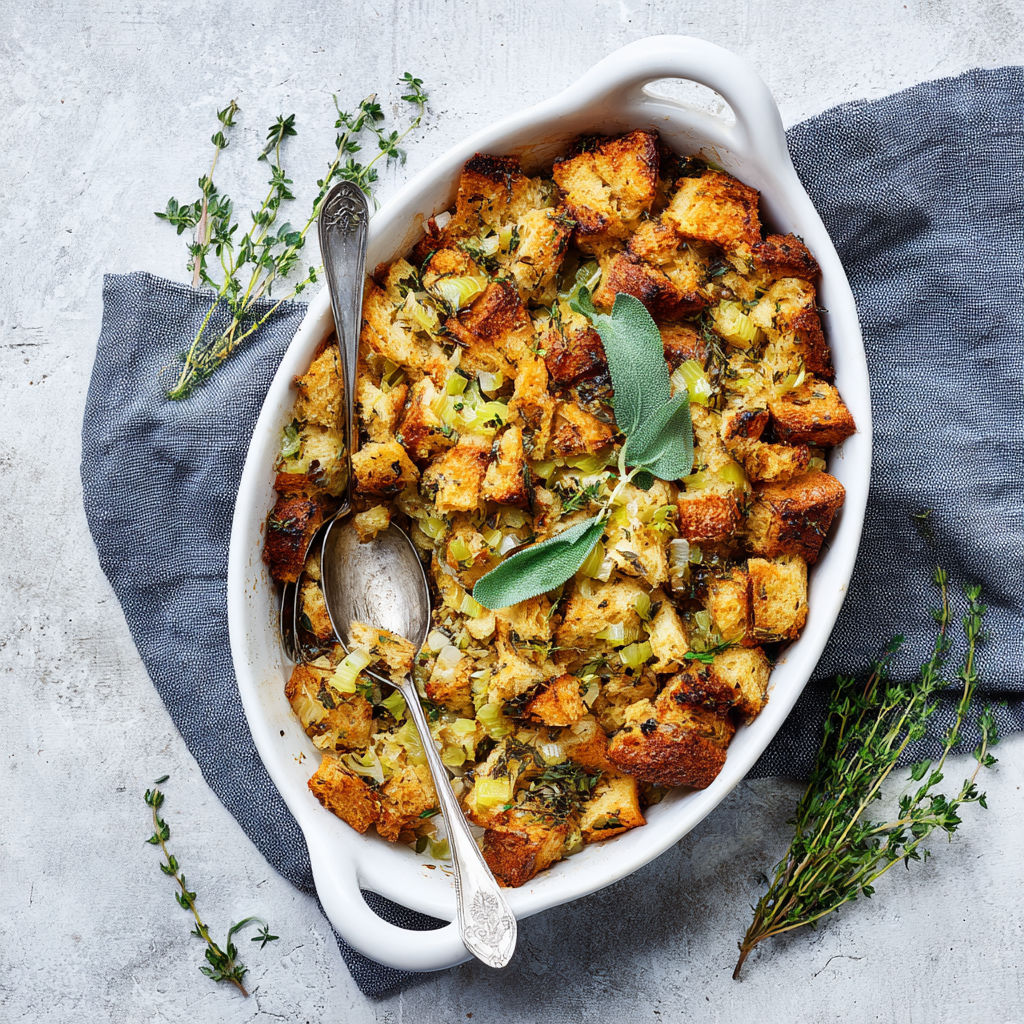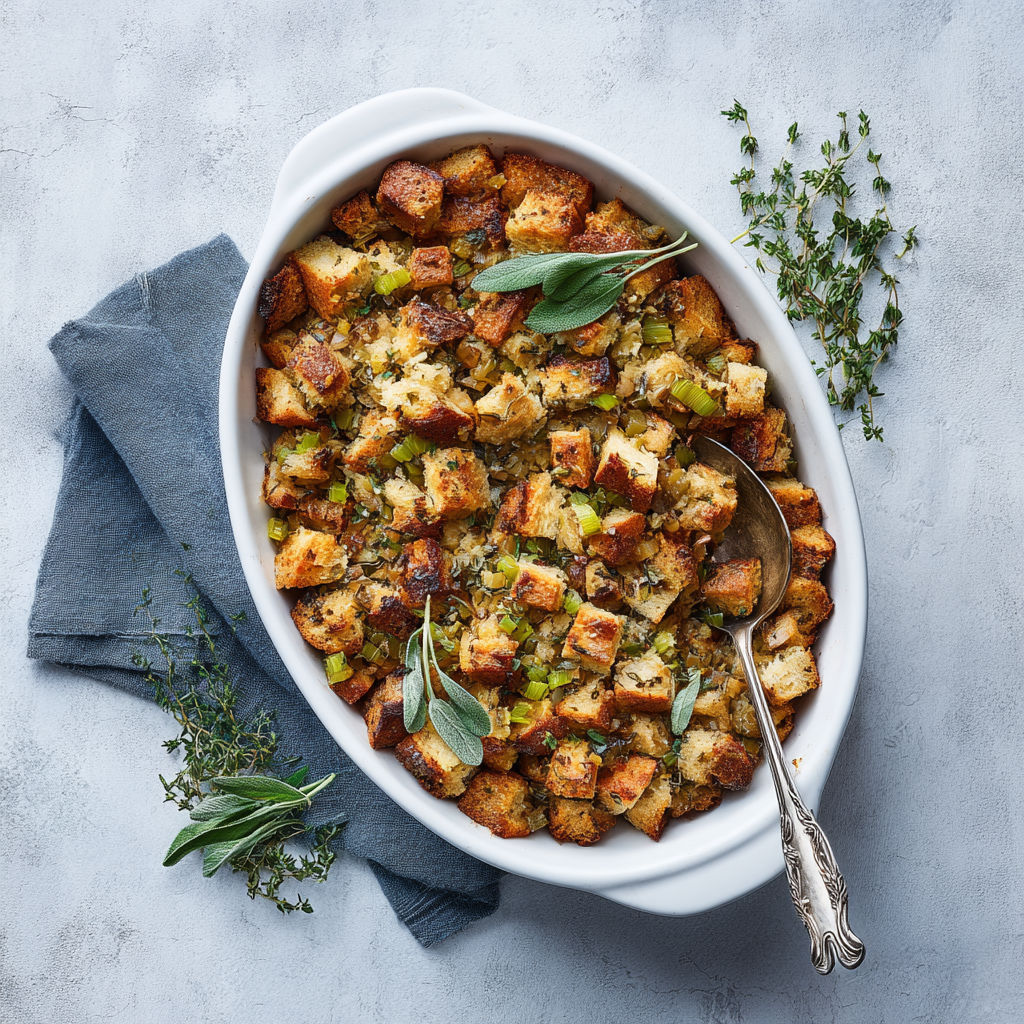 Pin
Pin
Nothing says Thanksgiving like a classic stuffing recipe baked until golden crisp on top and perfectly soft and savory inside. Classic stuffing is the ultimate comfort food, and it is hands down the most requested Thanksgiving side dish at my house for good reason. This easy stuffing recipe delivers homemade flavor with just pantry staples and takes about thirty minutes of hands on prep time with a forty five minute bake, making it perfect for holiday meals or a cozy Sunday dinner. Whether you are searching for a quick Thanksgiving recipe or planning ahead for a big gathering, know you will get a foolproof result every time with this classic stuffing recipe.
I started making this classic stuffing recipe over a decade ago after too many bland box mix dinners, searching for a stuffing that truly delivered savory, herb packed goodness. My family quickly declared it the best easy stuffing recipe, and now it is requested for every holiday and even as a comfort food casserole on chilly weekends. With each batch, I get to play with new herbs and local breads, ensuring the recipe stays deliciously fresh and satisfying year after year.
Gather Your Ingredients
- Yellow onions for savory depth: Use two medium yellow onions, diced small so they melt into the base; sweeter than white onions for balanced flavor. Try shallots for a subtler taste if needed.
- Celery ribs for crunch and aroma: Four to five ribs, finely chopped, add classic texture and earthiness. Organic celery is best for cleaner flavor, but regular works well.
- Unsalted butter for a golden crust: Eight tablespoons gives rich flavor and helps brown the top. Plant based butter is a great substitute for dairy free needs.
- Poultry seasoning or ground sage for classic taste: One and one half teaspoons poultry blend or half a teaspoon of ground sage, depending on your preference; both give that traditional Thanksgiving aroma. Choose fresh herbs for a brighter profile if desired.
- Kosher salt and freshly cracked black pepper for seasoning: Season to taste and adjust after mixing. Flaky sea salt can be swapped in for a subtle texture difference.
- Dry bread cubes for structure: Twelve cups of day old French bread, sourdough, or country white bread, cut and fully dried for best results; about 13 to 16 slices. Gluten free bread works if needed.
- Chicken broth or vegetable broth for moisture: Start with two cups and add more if needed to ensure cubes are moist but not soggy. Use low sodium broth to control salt levels, or homemade for richer flavor.
- Fresh parsley and mixed herbs for brightness: A half cup of chopped parsley with any fresh sage, thyme, or rosemary you enjoy. Add extra rosemary or thyme for more robust herbaceous notes.
How to Make Classic Stuffing Recipe
- Preheat Your Oven for the Best Bake:
- Set your oven to 350 degrees Fahrenheit so it is thoroughly hot and ready for even baking throughout. This guarantees a crispy golden crust that holds its shape, so do not skip the preheat step even if you are short on time.
- Sauté the Aromatics for Maximum Flavor:
- Melt eight tablespoons of butter in a large skillet over medium heat. Add diced onions, celery, and poultry seasoning or sage. Cook gently for ten to twelve minutes, stirring often until the onions are soft and fragrant and the celery turns translucent. The aroma should fill your kitchen with rich, herby notes, signaling the base is ready.
- Mix the Bread and Herb Base:
- Add the dried bread cubes to a large mixing bowl. Spoon in the cooked onion mixture, making sure to scrape all buttery bits. Sprinkle over fresh parsley and chopped herbs, tossing gently so every piece is evenly coated. Take your time to combine—this helps prevent any dry spots in the final bake.
- Moisten with Broth for the Perfect Texture:
- Drizzle one cup of broth over the bread mixture, tossing gently to start. Allow it to sit one minute to absorb, then slowly pour in remaining broth in small amounts, continuing to toss and pause. The bread should feel soft on the inside but not mushy and should hold its shape. Adjust seasonings with salt and pepper after tasting. Two to three cups of broth is usually perfect for this batch.
- Fill Your Baking Dish and Dot with Butter:
- Spoon the prepared stuffing mixture into a greased nine by thirteen inch baking dish. Spread it evenly and press lightly with the back of your spoon—avoid packing it too tightly. Dot the top with extra pieces of butter for extra golden brown finish and added crunch.
- Bake Until Golden and Fluffy:
- Cover the dish with foil and bake in your preheated oven for thirty five minutes. Remove the foil and continue baking another ten minutes until the top turns deeply golden and crisp. The center should be piping hot and fluffy. Let the stuffing cool five minutes before serving for best slicing and texture.

My favorite discovery for the best classic stuffing is using a hearty country loaf as the bread base, taking time to toast cubes in the oven for a perfect bite. I will never forget my youngest helping to tear up bread for our very first Thanksgiving in a new home, laughing as the kitchen filled with warm herby aromas. Little hands and simple tasks turn this side dish into a memory maker year after year.
Smart Swaps and Variations
Classic stuffing is easy to adapt based on dietary needs, seasonal produce, or what you have on hand. For gluten free stuffing, substitute your favorite gluten free bread cubes and check your broth for additives. Vegan and dairy free options are simple by swapping in quality plant based butter and vegetable broth. Looking for a Southern spin? Add cornbread cubes or stir in cooked sausage and apple for a classic sausage apple stuffing. Dried cranberries, mushrooms, or even roasted butternut squash work beautifully for new flavor twists—always taste and adjust herbs for seasonal balance.
How to Store and Reheat Classic Stuffing Recipe
Keeping your classic stuffing moist yet crisp is all about proper storage and gentle reheating. Once cooled, cover leftovers tightly and refrigerate for up to three days for best quality. For longer storage, freeze baked or unbaked stuffing in airtight containers or freezer bags for up to three months, labeling portions for easy reheating. To reheat, cover with foil and bake at 350 degrees Fahrenheit until hot, removing the foil for the last ten minutes to revive its crispy topping. If prepping ahead, assemble and refrigerate unbaked stuffing up to two days before baking as directed.
What to Serve with Classic Stuffing Recipe
Classic stuffing pairs perfectly with roast Thanksgiving turkey, juicy roast chicken, or beef prime rib for festive holiday meals. It also complements roasted butternut squash, green bean casserole, and fall salads packed with apples and nuts. For cozy weeknight comfort, fill baked portobello mushrooms with stuffing or plate alongside chicken sausage with hearty pan gravy. Add a glass of chardonnay or cranberry cider for the finishing touch to your spread.
Nutritional Benefits
Homemade stuffing delivers more than classic flavor—it is also packed with nutrition from fresh vegetables, herbs, and whole bread. Onions, celery, and parsley boost vitamins, antioxidants, and minerals that support immune health. Using homemade bread and plant based options offers complex carbohydrates and dietary fiber. With about 185 calories per serving, this dish fits easily into most balanced holiday or weeknight meals, especially when made with quality ingredients and moderate fat.
Recipe Success Tips
Stuffing can turn out dry if overbaked or if the bread cubes are too stale to absorb enough moisture. Add broth slowly in stages and wait before adding more to avoid wet or soggy stuffing. Mix bread types for layers of flavor, but avoid highly processed white bread that tends to go mushy. If your stuffing seems loose before baking, let it rest five minutes to firm up before putting it in the oven.

Classic stuffing has been the centerpiece of our Thanksgiving table for years, always winning over new guests with homemade flavor and simple comfort. Gather your family, enjoy each herby bite, and make this classic stuffing recipe your own holiday tradition.
Common Questions About This Recipe
- → What type of bread is best for stuffing?
Use any type of sturdy, day-old bread, such as French, Italian, or sandwich bread. Dried or lightly toasted bread cubes absorb flavors and prevent mushiness.
- → Can stuffing be made ahead of time?
Prepare the stuffing mixture up to 48 hours in advance and refrigerate. Bake it just before serving for the best texture and flavor.
- → How do I keep stuffing from getting soggy?
Add broth gradually, tossing lightly to moisten bread without making it mushy. Allow the mixture to rest so the bread can absorb the liquid evenly.
- → Can I add protein or extra vegetables?
Sautéed sausage, apples, or mushrooms add flavor and texture. Adjust seasoning and moisture if including extra ingredients.
- → Is this stuffing gluten-free?
For a gluten-free option, substitute dry gluten-free bread cubes and check that broth and seasonings are gluten-free.
